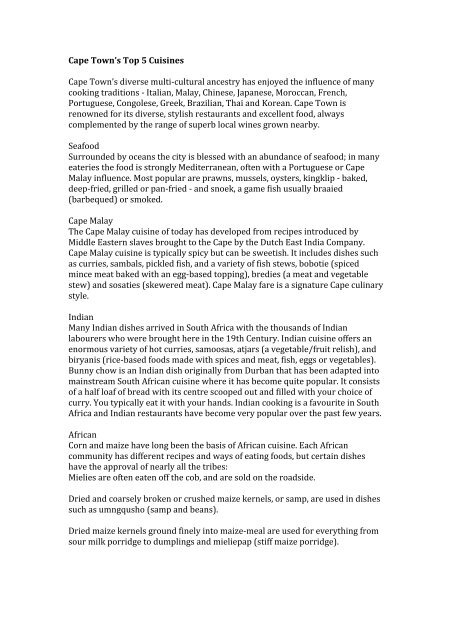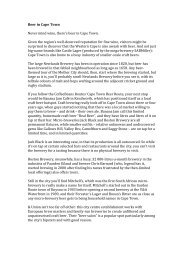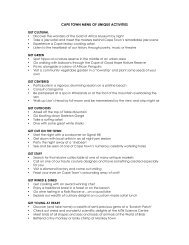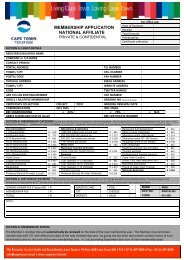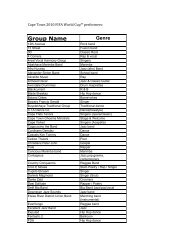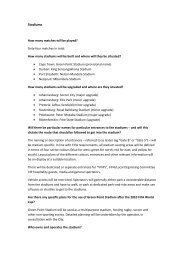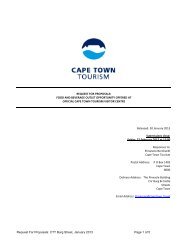Download - Cape Town Tourism
Download - Cape Town Tourism
Download - Cape Town Tourism
You also want an ePaper? Increase the reach of your titles
YUMPU automatically turns print PDFs into web optimized ePapers that Google loves.
<strong>Cape</strong> <strong>Town</strong>’s Top 5 Cuisines <strong>Cape</strong> <strong>Town</strong>’s diverse multi-‐cultural ancestry has enjoyed the influence of many cooking traditions -‐ Italian, Malay, Chinese, Japanese, Moroccan, French, Portuguese, Congolese, Greek, Brazilian, Thai and Korean. <strong>Cape</strong> <strong>Town</strong> is renowned for its diverse, stylish restaurants and excellent food, always complemented by the range of superb local wines grown nearby. Seafood Surrounded by oceans the city is blessed with an abundance of seafood; in many eateries the food is strongly Mediterranean, often with a Portuguese or <strong>Cape</strong> Malay influence. Most popular are prawns, mussels, oysters, kingklip -‐ baked, deep-‐fried, grilled or pan-‐fried -‐ and snoek, a game fish usually braaied (barbequed) or smoked. <strong>Cape</strong> Malay The <strong>Cape</strong> Malay cuisine of today has developed from recipes introduced by Middle Eastern slaves brought to the <strong>Cape</strong> by the Dutch East India Company. <strong>Cape</strong> Malay cuisine is typically spicy but can be sweetish. It includes dishes such as curries, sambals, pickled fish, and a variety of fish stews, bobotie (spiced mince meat baked with an egg-‐based topping), bredies (a meat and vegetable stew) and sosaties (skewered meat). <strong>Cape</strong> Malay fare is a signature <strong>Cape</strong> culinary style. Indian Many Indian dishes arrived in South Africa with the thousands of Indian labourers who were brought here in the 19th Century. Indian cuisine offers an enormous variety of hot curries, samoosas, atjars (a vegetable/fruit relish), and biryanis (rice-‐based foods made with spices and meat, fish, eggs or vegetables). Bunny chow is an Indian dish originally from Durban that has been adapted into mainstream South African cuisine where it has become quite popular. It consists of a half loaf of bread with its centre scooped out and filled with your choice of curry. You typically eat it with your hands. Indian cooking is a favourite in South Africa and Indian restaurants have become very popular over the past few years. African Corn and maize have long been the basis of African cuisine. Each African community has different recipes and ways of eating foods, but certain dishes have the approval of nearly all the tribes: Mielies are often eaten off the cob, and are sold on the roadside. Dried and coarsely broken or crushed maize kernels, or samp, are used in dishes such as umngqusho (samp and beans). Dried maize kernels ground finely into maize-‐meal are used for everything from sour milk porridge to dumplings and mieliepap (stiff maize porridge).
Maize is also mixed with sorghum and yeast to make umqombothi, a popular African beer, or with flour and water to make mageu, a refreshing non-‐alcoholic drink. Meat – beef, chicken, goat, and often tripe – is usually cooked over the fire. Afrikaans Foods most commonly attributed to the Afrikaner culture are based on Dutch cuisine, with contributions from French and German immigrants and the <strong>Cape</strong> Malay population. Boerewors (sausage), braai (a barbeque), potjiekos (a meat and/or vegetable stew cooked over a fire in a cast iron pot), frikadelle (meat balls), and vegetables sweetened with syrup, honey, cinnamon or sugar, are a few traditional Afrikaans dishes. South Africa is famous for its dried salted meat or biltong, and for its preserves known as konfyt -‐ pieces of fruit, and rind soaked in lime water, are cooked in syrup and spices. Please do not hesitate to contact <strong>Cape</strong> <strong>Town</strong> <strong>Tourism</strong> for suggestions on what to see and do, where to eat, how to get around and where to stay. Contact info@capetown.travel or call +27 (0)21 487 6800.


